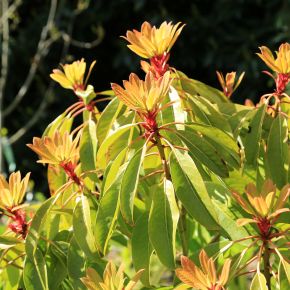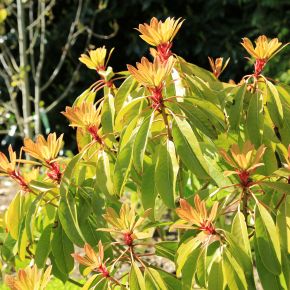Daphniphyllum macropodum
Family - Daphniphyllaceae
Category - Shrub
Origin - Japan, Korea, China
Discovered By - Charles Maries
Year of Introduction - 1879
Season of Interest - Spring, Summer, Autumn, Winter
Hardiness - H4
Height - up to 6m
Width - up to 6m
Location - The Woodland Walk
Description: A large, Evergreen Shrub with a rounded habit. The leathery leaves are mid to dark green, oblong to oval in shape and resemble the foliage of Rhododendron. Attractive red leaf stalks are visible through the foliage. The new growth emerges pale green, tinged with bronze, which contrasts nicely against the mature, dark green foliage. Male and female flowers are produced on separate plants (Dioecious). The fragrant flowers have no petals, are produced in late spring and are held beneath the foliage (often hidden). Male flowers consist of clusters of purple stamens, whereas female flowers are composed of green Carpels. If pollinated, the female flowers will be followed by round, black berries, covered in heavy Bloom (powder-like coating).
Synonym - Daphniphyllum himalense var. macropodum, D. glaucescens.
Flower:
Male and female flowers are produced on separate plants (dioecious). The flowers are fragrant and produced beneath the leaves in May. Male flowers consist of clusters of purple stamens. The female flowers are composed of green carpels, and if pollinated will be followed by bloom covered, black berries.
Flower colour: Purple, green
Flower shape: Apetalous
Flowering time: May
Foliage:
Leathery, dark green, oblong to oval leaves have attractive red leaf stalks. The new growth emerges bright pale green, tinged with bronze. The leaves are spirally arranged on the branches.
Foliage Senescence: Evergreen
Foliage Shape: Oblong or narrowly oval
Propagation:
Seed, cuttings.
Cultivation:
Best in a sheltered position in full sun to partial shade. Prefers fertile, moisture-retentive soil that is well-drained.



